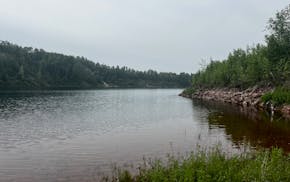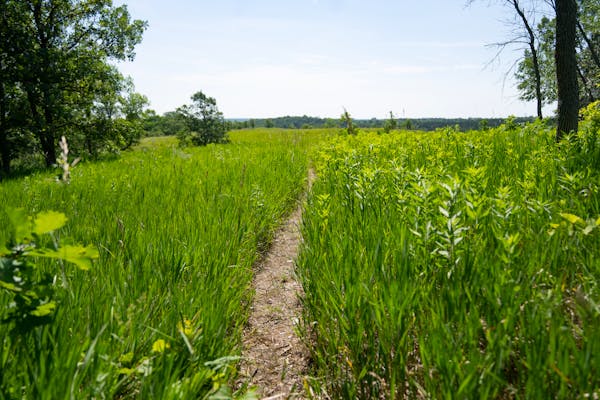UPPER SIOUX COMMUNITY - Before a word was said or a document was signed, boxes of tissues were laid out, at the ready.
It was an emotional day at the Upper Sioux Community, Pezihutazizi Oyate, in far western Minnesota, as the state officially returned Upper Sioux Agency State Park to the Dakota people.
The park, several people noted at Friday's ceremony, was originally created on the 100-year anniversary of the starvation of Dakota people on the land. The ensuing 1862 U.S.-Dakota War ended with the largest mass execution in the United States: 38 Dakota men hanged in Mankato.
Tribal Chair Kevin Jensvold marked a moment he said was at least 20 years in the making. The idea originated, he said, in a conversation with another tribal leader who mentioned that the community had to ask the state's permission to conduct ceremonies on the land.
"None of us were here back then to participate in the wrongs that happened, but we're here today … helping to make the rights," Jensvold said.
The 1,300-acre park at the confluence of the Minnesota and Yellow Medicine rivers is full of rolling prairie and wetlands. Before it closed to the public on Feb. 16, it received about 35,000 visitors a year, significantly lower than most of the 66 state parks.
The park is a sacred site, where Dakota people visit to pray or meditate, but also the site of deep trauma. Many Dakota people were left starving there in 1862 after promised payments from the U.S. government failed to arrive and traders refused to sell food on credit.
Desperation drove an attack against the Lower Sioux Agency, another government complex farther down the Minnesota River — an event now viewed as the start of the six-week war.
That dark history hung heavily over the ceremony to return the land.
"When there's an official treaty signing or official documents, that almost always ended in sorrow and tears for your community," Gov. Tim Walz said during the ceremony. "Today is not that day."
Implicit in the celebration was the fact that this story has not always been widely told across Minnesota. Rep. Zack Stephenson, DFL-Coon Rapids, said that he had not learned the history when he was growing up in the state, but felt moved to champion it as he sponsored the House bill that led to the land transfer.
Jensvold said after the celebration that it was not a day for blame, but for facing the truth of what had happened to this Dakota community, also known as the Yellow Medicine People.
"If we can't even face the truth, then we have a lot of learning to do as a society," he said.
The historic land transfer comes as state lawmakers consider several moves to return public land to Indigenous hands. One bill would give portions of the 160,000-acre White Earth State Forest to the White Earth Band of Ojibwe by 2029, as well as first refusal to buy any tax-forfeited land in the forest.
Another bill would transfer the eastern half of Upper Red Lake, a mile-wide buffer around it and some nearby public forest to the Red Lake Nation in Beltrami County.
Sen. Mary Kunesh, DFL-New Brighton, sponsored the Senate bill to return Upper Sioux Agency, and is sponsoring the new White Earth bill. She said before the ceremony that the return of the land to the Upper Sioux wasn't intended to start a wave of actions to put acres back in Native ownership — but it has started a conversation.
"It makes a lot of non-Native communities very nervous that the Indians are starting to take over," Kunesh, a descendant of the Standing Rock Lakota, later told the gathered crowd. "I don't see it as taking over. I see it as returning the stewardship of the land."
In some cases, tribes are buying back private land. In 2022, the Bois Forte Band of Chippewa purchased some 28,000 acres of privately held forest land in the band's reservation, then the largest transfer of its kind in the United States.
The Department of Natural Resources has pledged to help replace the amenities of the Upper Sioux Agency park, which is near the city of Granite Falls. In meetings held last year, some residents worried there would be little to draw people into the community or convince them to stay there.
No new plans were announced by the DNR for new amenities in the region Friday, but it will be an important campaign to continue to push, said Autumn Cavender, an Upper Sioux Community member who said she advocated for the land transfer.
Cavender noted that the now-closed state park was in need of several upgrades, making it an easy decision for the DNR to hand it over. The cultural center on the land was condemned, and a major road through it was crumbling, she said.
"This is a very weird and rare circumstance, where everyone can win," Cavender said. Making sure the park would be replaced would be "the next chapter."
She said she was looking forward to visiting the graves of her ancestors on the land, without the risk of getting a citation for being there.
Elitta Gouge, a former tribal secretary, also claims ancestors in the park — including her great-great-grandfather Mazomani, a Dakota leader who died during the 1862 war. The land had been a refuge for her in the past, a place she visited in gratitude when she learned her son had narrowly escaped boarding a plane that later crashed — and where she mourned a friend who had been on board.
When she returns to the former park, she said, "The first thing I will do is give thanks, and I will feel the spirits, and I will feel the creator's attention."
Gouge started the original conversation that inspired Jensvold to campaign for the land transfer. On Friday, DNR Commissioner Sarah Strommen brought that two-decade story to a close with a deep breath and a swift signature on the state park's deed.
The document was then whisked away, to be officially recorded at the Yellow Medicine County Courthouse.
Anderson: He paddled solo into the BWCA and didn't come back

Accomplished climber, photographer who recently moved from St. Paul missing on mountain
dj](https://arc.stimg.co/startribunemedia/34QSKO44B2XKVNUZCO5SLJQSLY.jpg?h=91&w=145&fit=crop&bg=999&crop=faces)
Some adults will soon need a permit to operate a boat or personal watercraft in Minnesota


